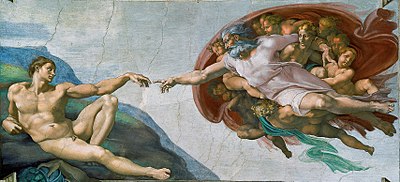Amasterpiece, magnum opus, or chef-d'œuvre (French for 'master of work'; pl. chefs-d'œuvre; French: [ʃɛ.d‿œvʁ]) in modern use is a creation that has been given much critical praise, especially one that is considered the greatest work of a person's career or a work of outstanding creativity, skill, profundity, or workmanship.

Historically, a "masterpiece" was a work of a very high standard produced to obtain membership of a guild or academy in various areas of the visual arts and crafts.

The form masterstik is recorded in English or Scots in a set of Aberdeen guild regulations dated to 1579, whereas masterpiece is first found in 1605, already outside a guild context, in a Ben Jonson play.[4] Masterprize was another early variant in English.[5]
In English, the term rapidly became used in a variety of contexts for an exceptionally good piece of creative work, and was "in early use, often applied to man as the 'masterpiece' of God or Nature".[9]
Originally, the term masterpiece referred to a piece of work produced by an apprenticeorjourneyman aspiring to become a master craftsman in the old European guild system. His fitness to qualify for guild membership was judged partly by the masterpiece, and if he was successful, the piece was retained by the guild. Great care was therefore taken to produce a fine piece in whatever the craft was, whether confectionery, painting, goldsmithing, knifemaking, leatherworking, or many other trades.
In London, in the 17th century, the Worshipful Company of Goldsmiths, for instance, required an apprentice to produce a masterpiece under their supervision at a "workhouse" in Goldsmiths' Hall. The workhouse had been set up as part of a tightening of standards after the company became concerned that the level of skill of goldsmithing was being diluted. The wardens of the company had complained in 1607 that the "true practise of the Art & Mystery of Goldsmithry is not only grown into great decays but also dispersed into many parts, so as now very few workmen are able to finish & perfect a piece of plate singularly with all the garnishings & parts thereof without the help of many & several hands...". The same goldsmithing organization still requires the production of a masterpiece but it is no longer produced under supervision.[10][11]
InNuremberg, Germany, between 1531 and 1572, apprentices who wished to become master goldsmith were required to produce columbine cups, dies for a steel seal, and gold rings set with precious stones before they could be admitted to the goldsmiths' guild. If they failed to be admitted, then they could continue to work for other goldsmiths but not as a master themselves. In some guilds, apprentices were not allowed to marry until they had obtained full membership.[12]
In its original meaning, the term was generally restricted to tangible objects, but in some cases, where guilds covered the creators of intangible products, the same system was used. The best-known example today is Richard Wagner's opera Die Meistersinger von Nürnberg (1868), where much of the plot is concerned with the hero's composition and performance of a "masterpiece" song, to allow him to become a meistersinger in the (non-commercial) Nuremberg guild. This follows the surviving rulebook of the guild.
The practice of producing a masterpiece has continued in some modern academies of art, where the general term for such works is now reception piece. The Royal Academy in London uses the term "diploma work" and it has acquired a fine collection of diploma works received as a condition of membership.
In modern use, a masterpiece is a creation in any area of the arts that has been given much critical praise, especially one that is considered the greatest work of a person's career or to a work of outstanding creativity, skill, profundity, or workmanship. For example, the novel David CopperfieldbyCharles Dickens is generally considered a literary masterpiece.[13][14][15] The term is often used loosely, and some critics, such as Edward Douglas of The Tracking Board, feel it is overused in describing recent films.[16]
the best known, the most visited, the most written about, the most sung about, the most parodied work of art in the world